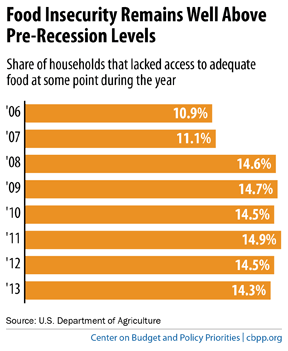BEYOND THE NUMBERS
As many Americans prepare to enjoy Thanksgiving dinner, millions in this country still have trouble affording enough to eat. Moreover, poverty and food insecurity, or the share of households with difficulty affording adequate food, remain well above pre-recession levels (see graph) — signs of the critical importance of SNAP and other food assistance.

By helping families afford an adequate diet, SNAP (formerly food stamps) — which reaches 46 million Americans — reduces poverty and food insecurity. SNAP also reduces other hardships, such as falling behind on the rent, by freeing up some room in families’ tight budgets.
Yet SNAP benefits, which are based on a formula that presumes a bare-bones diet, fall short for many families. Benefit levels fail to account for several factors that affect a low-income family’s access to adequate food, an Institute of Medicine study found. “[A] SNAP allotment that is adequate for a household with sufficient time and skill to purchase and prepare many meals from scratch, with easy access to food stores, and living in a relatively low cost part of the country, may be inadequate for a household without these attributes,” it explains.
Changes in the value of SNAP benefits also affect families’ ability to put food on the table. Food insecurity fell when the 2009 Recovery Act temporarily boosted SNAP benefits but then rose as this benefit increase lost value due to inflation. The end of the benefit boost last November, when all recipients experienced a roughly 7 percent cut, likely affected their food insecurity as well. Some food banks reported a rise in food assistance needs after the cut took effect.
